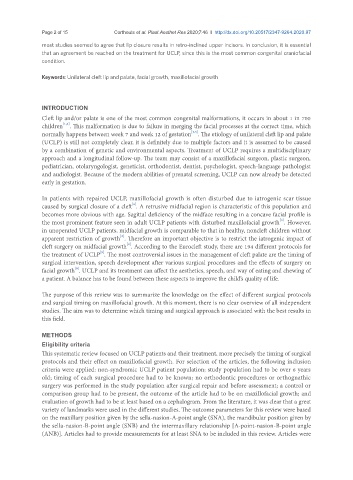Page 516 - Read Online
P. 516
Page 2 of 15 Corthouts et al. Plast Aesthet Res 2020;7:46 I http://dx.doi.org/10.20517/2347-9264.2020.97
most studies seemed to agree that lip closure results in retro-inclined upper incisors. In conclusion, it is essential
that an agreement be reached on the treatment for UCLP, since this is the most common congenital craniofacial
condition.
Keywords: Unilateral cleft lip and palate, facial growth, maxillofacial growth
INTRODUCTION
Cleft lip and/or palate is one of the most common congenital malformations, it occurs in about 1 in 700
[1,2]
children . This malformation is due to failure in merging the facial processes at the correct time, which
[1,3]
normally happens between week 7 and week 12 of gestation . The etiology of unilateral cleft lip and palate
(UCLP) is still not completely clear, it is definitely due to multiple factors and it is assumed to be caused
by a combination of genetic and environmental aspects. Treatment of UCLP requires a multidisciplinary
approach and a longitudinal follow-up. The team may consist of a maxillofacial surgeon, plastic surgeon,
pediatrician, otolaryngologist, geneticist, orthodontist, dentist, psychologist, speech-language pathologist
and audiologist. Because of the modern abilities of prenatal screening, UCLP can now already be detected
early in gestation.
In patients with repaired UCLP, maxillofacial growth is often disturbed due to iatrogenic scar tissue
[4]
caused by surgical closure of a cleft . A retrusive midfacial region is characteristic of this population and
becomes more obvious with age. Sagittal deficiency of the midface resulting in a concave facial profile is
[3]
the most prominent feature seen in adult UCLP patients with disturbed maxillofacial growth . However,
in unoperated UCLP patients, midfacial growth is comparable to that in healthy, noncleft children without
[2]
apparent restriction of growth . Therefore an important objective is to restrict the iatrogenic impact of
[4]
cleft surgery on midfacial growth . According to the Eurocleft study, there are 194 different protocols for
[5]
the treatment of UCLP . The most controversial issues in the management of cleft palate are the timing of
surgical intervention, speech development after various surgical procedures and the effects of surgery on
[6]
facial growth . UCLP and its treatment can affect the aesthetics, speech, and way of eating and chewing of
a patient. A balance has to be found between these aspects to improve the child’s quality of life.
The purpose of this review was to summarize the knowledge on the effect of different surgical protocols
and surgical timing on maxillofacial growth. At this moment, there is no clear overview of all independent
studies. The aim was to determine which timing and surgical approach is associated with the best results in
this field.
METHODS
Eligibility criteria
This systematic review focused on UCLP patients and their treatment, more precisely the timing of surgical
protocols and their effect on maxillofacial growth. For selection of the articles, the following inclusion
criteria were applied: non-syndromic UCLP patient population; study population had to be over 6 years
old; timing of each surgical procedure had to be known; no orthodontic procedures or orthognathic
surgery was performed in the study population after surgical repair and before assessment; a control or
comparison group had to be present, the outcome of the article had to be on maxillofacial growth; and
evaluation of growth had to be at least based on a cephalogram. From the literature, it was clear that a great
variety of landmarks were used in the different studies. The outcome parameters for this review were based
on the maxillary position given by the sella-nasion-A-point angle (SNA), the mandibular position given by
the sella-nasion-B-point angle (SNB) and the intermaxillary relationship [A-point-nasion-B-point angle
(ANB)]. Articles had to provide measurements for at least SNA to be included in this review. Articles were

